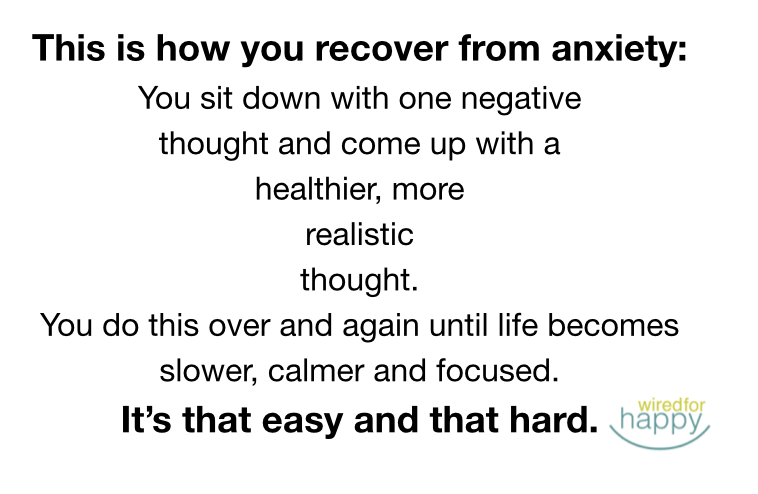How bad do you want happiness?
If you had to rate your efforts for the past twelve months from 1-10, what’s your number?
I honestly think most people reading this think they’re doing the happy hustle, when in reality, they fall way short.
There’s many variables for sure, but in the end, happiness (defined here as having more positive emotions than negative each day, healthy relationships, and meaningful connections with those around you) is freely available to you regardless of age, heritage, upbringing, or income level.
The good news is there’s literally two words that will change your life.
Whether your goal is happiness, less anxiety, more confidence or calm parenting, you must rewire that part of your brain that says, “I can’t.”
You do so by ruthlessly training your mind to reprogram those negative thoughts keeping you mired in misery. Like a prized boxer training for the fight of his life, you put in the grunt work when your mind and body are screaming at you to stop. Your counterattack?
Think differently
Pressed for time? Here’s the half-assed version:
For the intrepid mental wellness warriors, I offer six steps to start:
Step One: Focus on Thought Awareness
Your thoughts are rooted in your personality, values, and upbringing. Unique to you, they are your opinions of your inner self and the outside world. Believe it or not, some people do not recognize their negative thoughts. According to the National Science Foundation we have up to 50,000 thoughts per day.
Complicating matters is that many of our thoughts are automatic, and/or unconscious. Knowing what’s going on in your mind is the cornerstone of self-awareness. The first step to undoing any unhealthy habit is to recognize its existence. A useful tool is to keep a record of your most prevalent negative thoughts throughout the day. You don’t need to get fancy — a notebook, a word document or voice memo on your mobile device will do. After a couple weeks of recording your thoughts, you’ll notice negative patterns.
Step Two: Pay Attention to Troublesome Thoughts
The key is to strike a balance between spending enough time on your problems, but not over-doing it. The tendency may be to avoid your worries, but this habit only makes you more anxious. On the other hand excessive worry leads to rumination that can leave you feeling depleted, hopeless and more depressed. One helpful intervention is to schedule daily “worry time.” This could be ten minutes, or it could be thirty. Focus on the issues at hand, and what actions you can take to remedy your situation.
Step Three: Reframe Out Loud
Reframing negative thinking to more positive, realistic thoughts is crucial. Research shows that studying aloud is associated with better outcomes than studying silently. Prep like you would for a psychology exam and speak on it: “I didn’t reach my goals at work, but now I know what to focus on for the next quarter,” or “My marriage isn’t perfect, but intentional effort on listening to my partner rather than reacting to past arguments will improve our relationship.” We often see the error in our ways when we hear our own voices.
Step Four: Stop the Dysfunctional Thoughts Train in its Tracks!
Negative thoughts beget negative outcomes. Our minds are wired with a negative wp themes bias, so ignore misleading gut reactions telling you to throw in the towel. Flip the give up switch by recognizing what is within your control — think preparation, options and execution. Problem-solving can only occur when you’re open and flexible about your resources. Sometimes complaining is so ingrained, you practically need a crowbar to get out from under its toxic grip. Here’s a simple question to ask yourself when caught in the negativity cycle: “Is what I’m doing now helping?”
Speaking of help, are you signed up for Get Psyched! ? If interested in digging deep into your thought process, get it here:
Step Five: Let Go and Get Moving
Just as you designate time to worrying, you must let go and move on. We have a finite amount of mental energy daily, and you don’t have to solve all your problems overnight. A wonderful way to transition from negativity to reality is through activity. Go outside, walk your dog, talk to a neighbor, or go for a run. Nothing gets us out of our heads like physical activity.
Step 6: Be a Part of Team Happy
This step is not to be had within a four-minute article. It also requires another step. And it’s the main focus for my therapy clients and blog readers.
“Team Happy” is the membership portion of wiredforhappy.com. Members have 24/7 access to the digital library, and each month features a new wellness theme.
Bottom line — if you want to develop healthier emotional habits you need strategy, guidance, and accountability.
Serious about improving your mental health game? Great!
Click here for info on gettin’ down and dirty with (my favorite theme)Think Differently!
**********
Thanks for reading…if you liked this article, please give it a share.
—Linda









